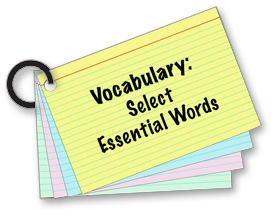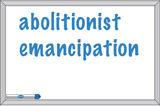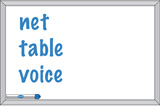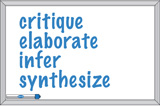What should content-area teachers know about vocabulary instruction?
Page 3: Selecting Essential Words

Teachers know that there is much more vocabulary than they have time to cover in class. Curricular materials, state standards, and local guidelines include lists of words thought to be crucial to understanding a given subject area. Even as they teach these recommended words, teachers might also need to add vocabulary terms that are unfamiliar to students because of their level of language proficiency or background knowledge in that area. These vocabulary lists can be overwhelming, and it might be necessary for teachers to decide which words in those lists are the most-essential to explicitly teach. Before they do so, however, it might be helpful for teachers to understand the information outlined in the table below.
| Vocabulary from content areas often contains | What this means | Examples |
| Uncommon words | Words that do not typically occur in a student’s vocabulary, though they may be important to a particular lesson or unit of instruction |  |
| Words with multiple meanings | Words that might be the same as those used every day but that have an entirely different and unfamiliar meaning when associated with particular content |  |
| Instructional or academic words | Terms commonly used at school and work (e.g., giving directions or asking questions) |  |
| Sophisticated synonyms | Words used in instruction that have more-common terms |  |
For Your Information
There is a shared vocabulary of instructional words (e.g., rate, process, analyze) that are not specific to any one content area. These words are often overlooked because no one teacher takes responsibility for teaching them. Teachers should be aware of these shared vocabulary words and make sure that students understand their meaning as they relate to a given content area.
What Can Teachers Do?
 Once teachers understand the common types of vocabulary found in academic lessons (e.g., uncommon words, instructional words, words with multiple meanings), they can be selective and teach a manageable number of them. They can be more efficient by teaching only those words that are unfamiliar to their students or that are inadequately defined in the materials. Teachers should choose words that are critical to understanding the main ideas and information of the unit or lesson. To do that, they can preview the content material and identify vocabulary words that are:
Once teachers understand the common types of vocabulary found in academic lessons (e.g., uncommon words, instructional words, words with multiple meanings), they can be selective and teach a manageable number of them. They can be more efficient by teaching only those words that are unfamiliar to their students or that are inadequately defined in the materials. Teachers should choose words that are critical to understanding the main ideas and information of the unit or lesson. To do that, they can preview the content material and identify vocabulary words that are:
- Relevant to what students need to learn
- Used often within a unit or across two or more units of instruction
- Linked to content standards
- Abstract or not easily pictured (often derived words ending with -tion, -ment, -ity, etc.)
- Difficult to understand without sufficient background knowledge or contextual support
- Naturally related or have logical relationships to other words in the content

Elfrieda Hiebert, PhD
Research Associate
University of California, Santa Cruz
(time: 1:40)

Deborah K. Reed, PhD
College of Education, University of Iowa
Director, Iowa Reading Research Center
(time: 2:09)
Transcript: Elfreida Hiebert, PhD
Vocabulary, the labels we give things are actually the essence of a content area. So teaching vocabulary, being aware of the vocabulary as a teacher, is really central. When we think of vocabulary in content areas, we might think about the major themes and the ideas, but ideas are always represented by words, and there are critical words in any content area that without that knowledge it’s very difficult to get the gist of the information. So when we think of content-area instruction, we know that the key ideas need to be supported through additional discussion and experiences. It’s rare that the vocabulary in a content area is vocabulary that students use in their everyday language in their everyday conversations. So what we really need to do is to have a sense of what the key concepts are in ensuring that those concepts are raised intentionally and explicitly in our instruction. In particular, we have to make sure that we provide the hooks across the ideas, across the vocabulary and content areas.
Transcript: Deborah K. Reed, PhD
I think what content-area teachers want to know is how is this going to help with my material? The rare words are the ones that are most important for students to get what they need to learn in that content area or in that subject. Those are the ones that are critical to understanding the text that students are reading, the lectures that teachers are giving, the activities that are happening in the classroom. If we can relate the selection of the words to the concepts that students are learning in those classes, we help teachers understand what’s important. I usually recommend that teachers consult their state standards or the common-core standards on the subject area and any district scope and sequence that exists to help them prioritize the words, because they’re likely to be many more words that they think students need to learn or don’t know than what can actually be accomplished in the class. They should also look at their various resources, the textbooks and other ancillary materials that they plan to use in the class to see what the publisher has identified as an important word or that the teacher knows the students don’t quite understand yet. If it’s a concept or a term that, based on this particular student population, that will cause problems in comprehension then the teachers need to look for that and not just trust that the publishing company has already found all of the words that will give students difficulty. Teachers know their students best. They need to take some of the background knowledge and the previous lessons that they’ve covered into consideration when they’re selecting the words. I also tell teachers to talk to each other, to consult their colleagues, because I don’t think that there is one right way to select the words or one right answer for the list of words that need to be taught. If it were that simple, I think that we would have mastered this a long time ago.